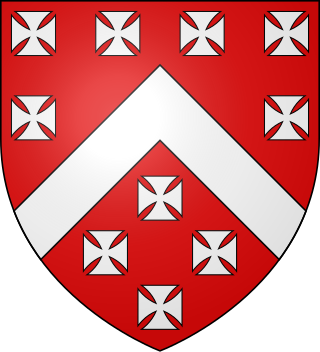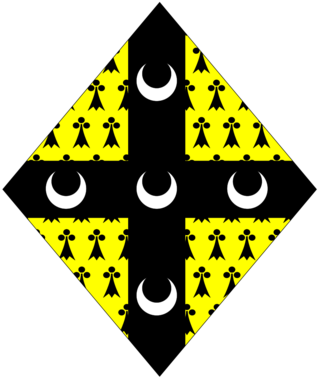
Earl of Castlehaven was a title in the Peerage of Ireland, created on 6 September 1616. It was held in conjunction with the Barony of Audley, the Barony of Audley of Orier, and the Barony of Audley of Hely.

George Tuchet, 1st Earl of Castlehaven, was the son of Henry Tuchet, 10th Baron Audley and his wife, née Elizabeth Sneyd.

Mervyn Tuchet, 2nd Earl of Castlehaven, was an English nobleman who was convicted of rape and sodomy and subsequently executed. He is the only member of parliament to be executed for a non-political crime.

James Tuchet, 3rd Earl of Castlehaven was the son of Mervyn Tuchet, 2nd Earl of Castlehaven and his first wife, Elizabeth Barnham. Castlehaven played a prominent role in the Wars of the Three Kingdoms that took place in the middle of the 17th century, and was particularly active in the conflicts in Ireland at this time.

Mervyn Tuchet, 4th Earl of Castlehaven was the third son of Mervyn Tuchet, 2nd Earl of Castlehaven, and his first wife, Elizabeth Barnham. He succeeded his brother James Tuchet as Earl of Castlehaven on 11 October 1684. He also held the subsidiary titles 14th Baron Audley and 2nd Baron Audley of Hely.
John Talbot Tuchet, 8th Earl of Castlehaven was the son of James Tuchet, 6th Earl of Castlehaven, and his wife, née Elizabeth Arundell. He succeeded his brother as Earl of Castlehaven and Baron Audley on 6 May 1769.

Baron de Ros of Helmsley is the premier baron in the Peerage of England, created in 1288/89 for William de Ros, with precedence to 24 December 1264. Premier baron is a designation and status awarded to the holder of the most ancient extant barony of the Peerage of England. Before the Dissolution of the Monasteries the Prior of the Order of St John in England was deemed the premier baron.

Baron Hastings is a title that has been created three times. The first creation was in the Peerage of England in 1290, and is extant. The second creation was in the Peerage of England in 1299, and became extinct on the death of the first holder in c. 1314. The third creation was in the Peerage of England in 1461, and has been in abeyance since 1960.

Baron FitzWalter is an ancient title in the Peerage of England. It was created on 24 June 1295 for Robert FitzWalter. The title was created by writ, which means that it can descend through both male and female lines.

The title Baron Berkeley originated as a feudal title and was subsequently created twice in the Peerage of England by writ. It was first granted by writ to Thomas de Berkeley, 1st Baron Berkeley (1245–1321), 6th feudal Baron Berkeley, in 1295, but the title of that creation became extinct at the death of his great-great-grandson, the fifth Baron by writ, when no male heirs to the barony by writ remained, although the feudal barony continued. The next creation by writ was in 1421, for the last baron's nephew and heir James Berkeley. His son and successor William was created Viscount Berkeley in 1481, Earl of Nottingham in 1483, and Marquess of Berkeley in 1488. He had no surviving male issue, so the Marquessate and his other non-inherited titles became extinct on his death in 1491, whilst the barony passed de jure to his younger brother Maurice. However, William had disinherited Maurice because he considered him to have brought shame on the noble House of Berkeley by marrying beneath his status to Isabel, daughter of Philip Mead of Wraxhall, an Alderman and Mayor of Bristol. Instead, he bequeathed the castle, lands and lordships comprising the Barony of Berkeley to King Henry VII and his heirs male, failing which to descend to William's own rightful heirs. Thus on the death of King Edward VI in 1553, Henry VII's unmarried grandson, the Berkeley inheritance returned to the family. Therefore, Maurice and his descendants from 1492 to 1553 were de jure barons only, until the return of the title to the senior heir Henry, becoming de facto 7th Baron in 1553. Upon his death he was succeeded by his relative George Harding.

Baron Strange is a title which has been created four times in the Peerage of England. Two creations, one in 1295 and another in 1326, had only one holder each, upon whose deaths they became extinct. Two of the creations, that of 1299 and that of 1628, are extant. The surname Le Strange was Latinized as Extraneus. The arms of Le Strange of Knockin Castle in Shropshire were: Gules, two lions passant argent.

Baron Howard de Walden is a title in the Peerage of England. It was created by writ of summons in 1597 by Queen Elizabeth I for Admiral Lord Thomas Howard, a younger son of Thomas Howard, 4th Duke of Norfolk, by his second wife, the Honourable Margaret Audley, daughter of Thomas Audley, 1st Baron Audley of Walden.
George Thicknesse, later Thicknesse-Touchet, 19th Baron Audley was an English peer.

Baron North, of Kirtling Tower in the County of Cambridge, is an abeyant title in the Peerage of England. Its most famous holder was Frederick North, 2nd Earl of Guilford, 8th Baron North, who served as Prime Minister of Great Britain from 1770 to 1782, a period which included most of the American Revolutionary War.

The Stanley family is an English family with many notable members, including the Earls of Derby and the Barons Audley who descended from the early holders of Audley and Stanley, Staffordshire. The two branches of the Audley family were made Barons Audley but both ended in the male line in the 14th century, after which their considerable estates were passed to a number of female heiresses, while the Stanleys would be elevated in the 15th century first to Barons Stanley and then Earls of Derby, a title they continue to hold.
Tuchet is a surname, and may refer to:

James Audley, 2nd Baron Audley of Heighley Castle, Staffordshire, was an English peer. He was the son and heir of Nicholas Audley, 1st Baron Audley (1289–1316) by his wife Joan Martin, who was the daughter of William Martin, feudal baron of Barnstaple, and Marcher Lord of Kemes. She was posthumously the eventual sole heiress of her brother William FitzMartin to Barnstaple and Kemes.

John Tuchet, 8th Baron Audley, 5th Baron Tuchet was an English peer.

John Tuchet, 4th Baron Audley, 1st Baron Tuchet was an English peer.

The title Baron Cobham has been created numerous times in the Peerage of England; often multiple creations have been extant simultaneously, especially in the fourteenth century.














